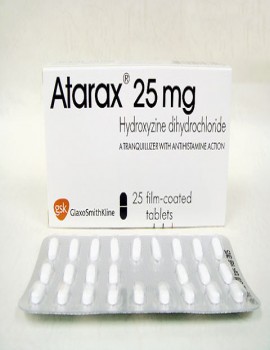In-Depth Insight into Atarax (Hydroxyzine) in the USA
Atarax, pharmacologically recognized as hydroxyzine, is a widely utilized medication within the USA, particularly renowned for its effectiveness in alleviating itching resulting from various allergic reactions. As a potent antihistamine, hydroxyzine functions by inhibiting the action of histamine, a naturally occurring chemical in the body that is released during allergic responses. This release often leads to a multitude of discomforting symptoms including, but not limited to, itching, sneezing, and a runny nose. Beyond its primary application in treating allergic reactions, hydroxyzine is also employed in the short-term management of anxiety-related disorders in the USA. Additionally, it serves as a sedative, facilitating relaxation for patients during pre-operative and post-operative periods, thereby enhancing overall procedural comfort.
Dosage and Administration Guidelines for Atarax (Hydroxyzine) in the USA
Atarax is primarily administered orally, and adherence to the specific dosing instructions provided by your healthcare provider is critical in the USA. This medication can be taken with or without food, typically three to four times daily. However, the exact frequency and dosage are tailored to meet the individual needs of each patient, based on factors like age, medical history, and therapeutic response. For those who are prescribed the liquid formulation of hydroxyzine, accuracy in dosing is paramount; patients should utilize a calibrated measuring device or dosing spoon to ensure precise measurements, as the use of common kitchen utensils can lead to serious dosing errors.
The prescribed dosage takes into account a variety of factors, such as the patient’s age and medical background. For pediatric patients, dosages are often determined based on the child’s weight, emphasizing the importance of individualized treatment plans. It is vital to follow the recommended dosage schedule strictly; patients should reach out to their healthcare provider immediately if symptoms persist or worsen despite treatment.
Common Side Effects of Atarax (Hydroxyzine) in the USA
While Atarax is generally well-tolerated, some patients may experience side effects that warrant attention in the USA. The most commonly reported adverse effects include drowsiness, dizziness, blurred vision, constipation, and dry mouth. Should any of these symptoms become particularly bothersome or increase in severity, consulting with a healthcare professional is advisable. For those dealing with the discomfort of dry mouth, effective home remedies include sucking on sugarless hard candies, chewing sugar-free gum, sipping water regularly, or utilizing saliva substitutes to maintain moisture.
Although many individuals experience mild or negligible side effects, vigilance is essential for recognizing severe or unusual reactions. Rare but serious side effects could manifest as marked changes in mood or mental state, including symptoms like restlessness, confusion, hallucinations, tremors, or difficulties with urination. In the event of serious side effects such as seizures, rapid or erratic heartbeats, extreme dizziness, or fainting immediate medical intervention is necessary. Though infrequent, severe allergic reactions may arise and are characterized by symptoms such as widespread rashes, swelling in the face or throat, significant dizziness, or breathing difficulties, all of which require urgent medical attention.
Precautions and Warnings When Using Atarax (Hydroxyzine)
Before commencing treatment with Atarax, it’s crucial to engage in an extensive discussion with your healthcare provider regarding your complete medical history in the USA. This dialogue should pay particular attention to any known allergies to hydroxyzine, as well as to related agents such as cetirizine or levocetirizine. Hydroxyzine may contain inactive components that could provoke allergic reactions or exacerbate existing health conditions.
Patients should fully disclose any pre-existing medical conditions to their healthcare provider, particularly those related to the respiratory system, such as asthma or emphysema, ocular conditions like glaucoma, hypertension (high blood pressure), renal or hepatic complications, a history of seizures, gastrointestinal disorders (including ulcers or blockages), hyperthyroidism, or urinary difficulties secondary to an enlarged prostate.
A crucial consideration is the potential for Atarax to trigger QT prolongation, a specific heart rhythm disorder that can lead to severe, potentially life-threatening arrhythmias in the USA. Individuals with a history of cardiac issues, especially those related to QT prolongation or sudden cardiac death, must inform their healthcare provider. The risk of QT-related complications may be heightened if the patient is concurrently taking other medications that affect the QT interval or if there are low potassium or magnesium levels in the blood due to certain health conditions or medications that induce significant fluid loss, such as severe vomiting or excessive sweating.
Additional Considerations for Patients Taking this medication
Patients on Atarax (hydroxyzine) should exercise caution due to the medication’s potential to cause drowsiness, dizziness, and blurred vision, effects that may be intensified when combined with alcohol or marijuana use in the USA. As a precautionary measure, it is advisable to avoid driving, operating heavy machinery, or engaging in activities that demand heightened alertness until the individual is confident in their ability to do so safely. Additionally, alcohol consumption should be strictly avoided while taking this medication, and any use of marijuana should be discussed with a healthcare provider for safety.
For patients scheduled for surgical procedures, it is imperative to inform all healthcare providers involved including dentists about all medications currently being taken, including those prescribed for other health conditions. This level of transparency is crucial to ensuring a safe and effective surgical experience, as it allows for the appropriate management of medications to mitigate any potential interactions or complications.




